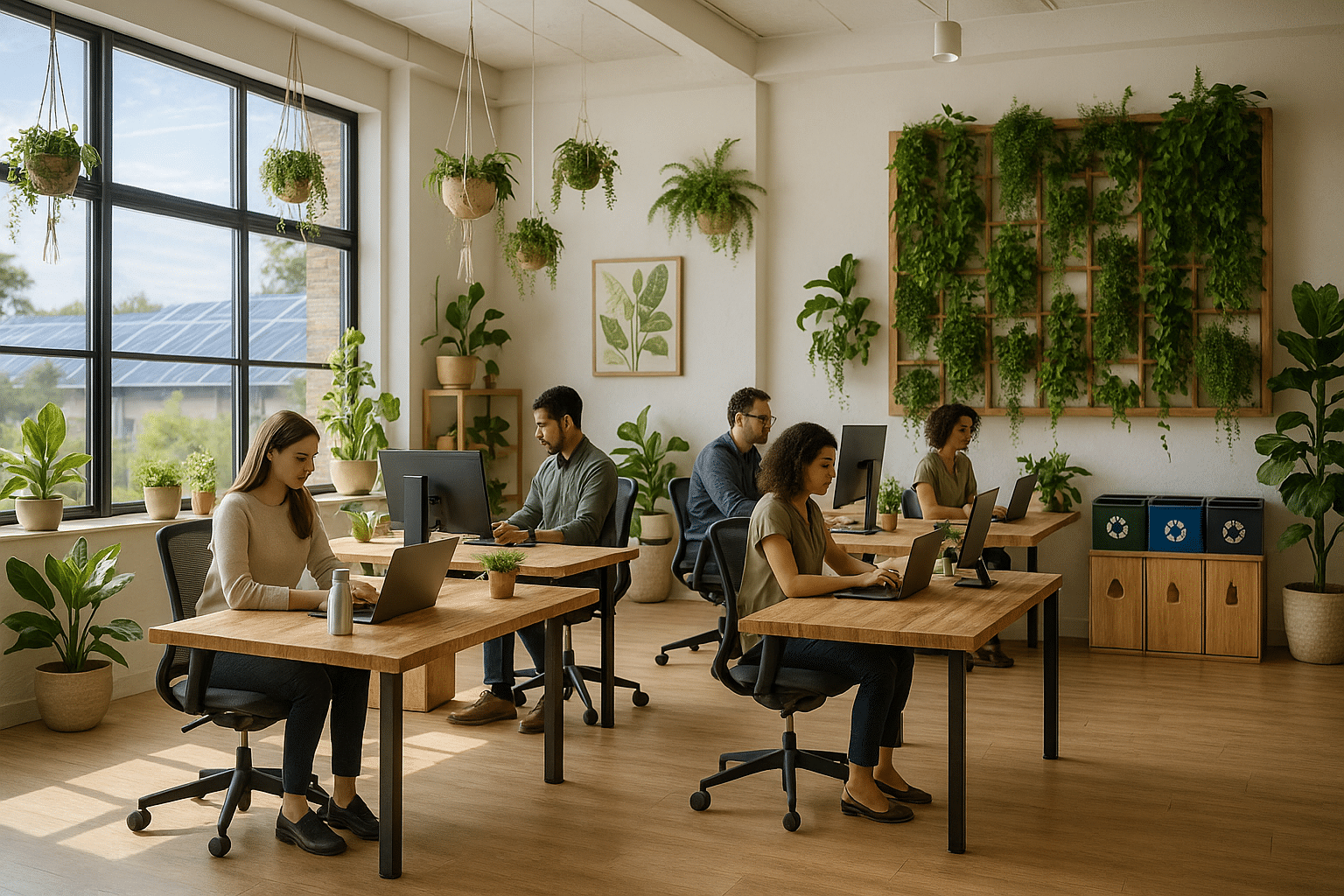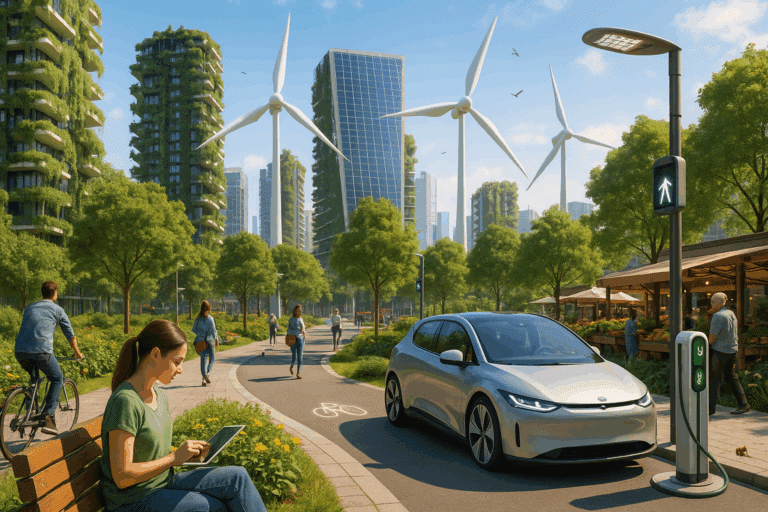Among the various frontiers leading this change, the concept of zero-waste offices stands as a paragon, revolutionizing traditional workplace norms. 🌎
As the moniker suggests, zero-waste offices aim to significantly reduce waste output, if not eliminate it altogether. But how exactly do they achieve this feat? What practices and technologies underpin this burgeoning paradigm shift? And more importantly, how can you, too, implement these changes within your own office environment? Let’s embark on this enlightening journey together.
At first glance, the prospect of achieving a zero-waste office might seem overwhelming, if not downright impossible. After all, an office environment, by its very nature, is a hotbed of resource consumption and waste production. 📊
However, when we delve deeper into the subject, we find that with the right approach, informed decisions, and technological advancements, it’s not only feasible but also financially and ethically rewarding. This article will provide a comprehensive guide to understanding and implementing the zero-waste office philosophy.
But before we dive into the specifics, let’s first set the stage by discussing the core principles of zero-waste offices. After all, it’s essential to comprehend the ethos driving this change to appreciate its significance and make informed choices.
Understanding the Zero-Waste Philosophy
At its core, the zero-waste philosophy espouses a shift from our prevalent linear economic model, which is based on a ‘take-make-dispose’ principle, to a more sustainable, circular model. This model aims to design out waste and pollution, keep products and materials in use, and regenerate natural systems. Essentially, it’s about creating a closed-loop system that mimics nature’s cycles. 🔄
Zero-Waste Offices: Leading the Sustainability Movement
Now that we have a basic understanding of the zero-waste philosophy let’s explore how it’s revolutionizing workplaces. We’ll delve into the unique practices and technologies that zero-waste offices are adopting, the benefits they’re reaping, and how they’re leading the sustainability movement.
In essence, our journey will traverse through key areas like waste management strategies, green procurement policies, digital transformation, employee engagement, and benefits of a zero-waste office. Each section will provide insights into different facets of the zero-waste philosophy, offering practical examples, tips, and guidance on how to implement these practices in your own workspace.
Rest assured, whether you’re a business owner contemplating a shift towards sustainability, an employee aiming to make a difference in your workplace, or simply a curious reader interested in understanding this fascinating shift, this article has something for you. So, let’s gear up and step into the exciting world of zero-waste offices, exploring how they’re leading the sustainability movement and setting a benchmark for the workplaces of the future. 🚀
Stay with us on this exploration, and by the end of it, you’ll be well-equipped to start your journey towards a zero-waste office environment. So, are you ready to be part of the revolution?
The New Frontier: Zero-Waste Offices and Sustainable Business Practices
In an era where businesses are increasingly aware of their impact on the environment, sustainable practices are no longer a choice but a necessity. Leading the way in this green revolution are zero-waste offices. These are workplaces that prioritize reducing, reusing, and recycling, aiming to send absolutely no waste to landfills. They are transforming traditional business operations, becoming standard-bearers of the sustainability movement.
But what exactly is a zero-waste office, and how is it revolutionizing workplaces? Let’s delve deeper into this fascinating topic.
Understanding the Concept of Zero-Waste Offices
At its core, a zero-waste office is an establishment that practices sustainability by striving to eliminate waste entirely. This is achieved through a series of processes and strategies aimed at preventing waste production, recycling resources, and promoting sustainable business practices.
Adopting a zero-waste approach involves much more than just recycling paper or using reusable cups. It calls for a complete shift in the way businesses think about waste and resources. It’s about viewing waste not as trash, but as a misallocated resource, something that can be put back into the system instead of being discarded.
Key Practices of Zero-Waste Offices
Every zero-waste office employs a unique strategy to reduce waste, tailored to their specific needs and resources. However, there are a few practices that are commonly observed across most zero-waste workplaces. Let’s explore these in detail.
1. Emphasizing on Reducing and Reusing
One of the primary principles of a zero-waste office is the emphasis on reducing and reusing. Businesses implement measures to limit the amount of resources used and find creative ways to reuse materials. This could include implementing paperless policies, encouraging employees to bring their own cups and utensils, or reusing shipping and packaging materials.
2. Comprehensive Recycling Programs
Recycling is another fundamental component of zero-waste offices. Comprehensive recycling programs are established, with clear guidelines for separating and disposing of different types of waste. Recycling stations are set up throughout the workplace to encourage employees to properly dispose of their waste.
3. Procurement Policies that Support Sustainability
A zero-waste office also incorporates sustainability into its procurement policies. This means choosing suppliers who align with their green values, purchasing products with minimal packaging, and prioritizing goods that are recyclable or compostable.
How Zero-Waste Offices are Revolutionizing the Workplace
The advent of zero-waste offices is causing a significant shift in the business landscape. These are some of the ways they are revolutionizing workplaces.
1. Fostering Environmental Consciousness
Zero-waste offices are transforming workplaces by fostering a culture of environmental consciousness. They are making sustainability a core business value, encouraging employees to be mindful of their waste production and resource consumption. This, in turn, is influencing personal habits, and helping to propagate the concept of zero-waste beyond the office.
2. Setting New Standards in Business Operations
By adopting zero-waste practices, businesses are setting new standards in operations. They are demonstrating that it is possible to operate efficiently while minimizing environmental impact. This is challenging traditional business models and prompting others to follow suit.
3. Driving Innovation
The quest for zero-waste is also driving innovation. Businesses are coming up with creative solutions to reduce waste, from inventing new recycling technologies to designing products that can be reused or composted. This wave of innovation is not only helping the environment but also creating opportunities for growth and development.
The Impact of Zero-Waste Offices: A Comparative Analysis
As zero-waste offices continue to proliferate, their impact is becoming increasingly evident. Let’s examine how zero-waste offices stack up against traditional offices in terms of waste production, energy use, and overall environmental impact.
| Zero-Waste Offices | Traditional Offices | |
|---|---|---|
| Waste Production | Significantly lower, due to a focus on reducing, reusing, and recycling. | Higher, as waste reduction practices are not typically emphasized. |
| Energy Use | Lower, thanks to energy-efficient appliances and practices. | Higher, due to greater reliance on traditional energy sources and appliances. |
| Environmental Impact | Reduced impact, due to lower waste production and energy use. | Higher impact, due to larger waste production and energy footprint. |
As you can see, zero-waste offices outperform traditional offices in all aspects, making a strong case for their widespread adoption.
Case Study: Successful Zero-Waste Offices
There are many examples of successful zero-waste offices around the world. These businesses have successfully implemented zero-waste practices, inspiring others with their success. Let’s take a look at one such example.
Google: A Global Leader in Sustainability
Google, the tech giant, has been a global leader in sustainability. The company has pledged to operate completely on renewable energy, and its offices worldwide implement robust recycling programs. In addition to composting food waste, Google also donates unused food from its cafeterias to local shelters, thus minimizing waste and contributing to the community. To learn more about Google’s sustainability efforts, check out this video: “Google’s Green Energy Purchases Outpace Its Data Center and Office Use” (by Google).
Embrace the Zero-Waste Movement in Your Office
Embracing a zero-waste philosophy in your office is an excellent way to contribute to the sustainability movement. It’s not just about saving the environment – it also makes good business sense. By adopting zero-waste practices, you can improve efficiency, save money, and build a positive brand image.
Don’t be daunted by the idea of transitioning to a zero-waste office. Start small, and gradually implement more sustainable practices. Remember, every little bit counts, and your efforts can make a real difference.
As the zero-waste movement continues to grow, we can expect to see more and more businesses joining the revolution. Will you be one of them?

Conclusion
In conclusion, we’ve explored the vast expanse of Information Technology (IT) and engineering, delving deep into the complexities of various concepts and issues. We’ve meticulously dissected the intricate mechanisms involved in the field of Software Engineering, carefully unravelling the many layers involved in its application and execution.
The principal points we tackled throughout this journey include understanding the fundamental tenets of IT, the crucial role of software engineering in the current technological era and the multifaceted challenges faced by professionals in the industry. We also demystified the various software development methodologies, providing a comprehensive understanding of the processes involved in each one.
It’s evident that the influence of IT and engineering is ubiquitous in our lives, shaping our personal and professional spheres in countless ways. In today’s digital age, it’s more crucial than ever to have a strong grasp of these areas, not only for those directly involved in the field but for anyone wishing to stay updated in an increasingly tech-driven world.
The understanding of software engineering is not only beneficial for developers and IT professionals. It also equips entrepreneurs, project managers and other professionals with a better understanding of the technology they rely on. Moreover, it facilitates more effective communication with tech teams, ultimately leading to more efficient and successful projects.
As we move forward, we must continually strive to expand our knowledge and adapt to the ever-evolving technological landscape. Remember, the power to shape the future lies in our understanding of the present. So, let’s continue to learn, grow and innovate together! 🚀
You’re invited to apply what you’ve learned, share this content with others who may find it beneficial, and feel free to comment with your thoughts or questions. It’s through sharing and exchanging ideas that we all grow. 😊
For further reading and reference, you can visit these active sources:
Source1 👈
Source2 👈
Source3 👈
Thanks for your attention throughout this extensive exploration of IT and engineering. Let’s keep the conversation going. See you in the comments section! 💬👋
#IT #SoftwareEngineering #TechKnowledge #Learning #Share
Remember: “The only source of knowledge is experience.” – Albert Einstein



